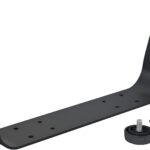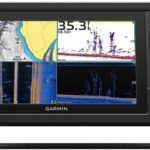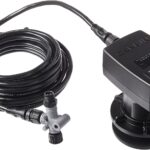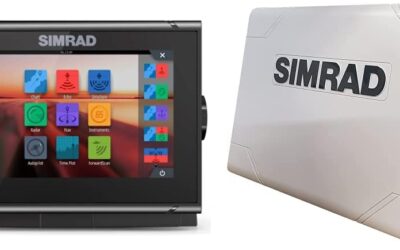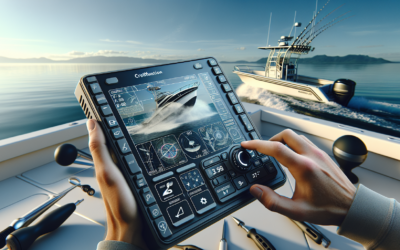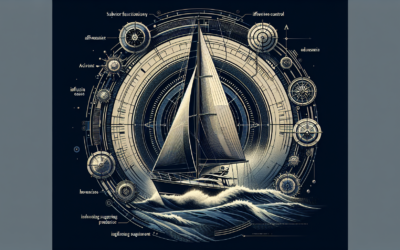If you’ve ever found yourself staring at a wall of fish finders in a store, feeling completely overwhelmed and unsure of where to start, you’re not alone. With so many options and features to choose from, finding the right fish finder for your needs can be a daunting task. That’s where “Choosing Your First Fish Finder: A Guide for First-time Buyers” comes in. Packed with valuable information and expert advice, this comprehensive guide will walk you through everything you need to know about selecting the perfect fish finder for your fishing adventures. From understanding the different types of fish finders to deciphering complex features, this guide is your go-to resource for making an informed decision and embarking on your journey as a first-time fish finder buyer.
Consider Your Fishing Needs and Goals
When it comes to choosing a fish finder, it’s important to consider your fishing needs and goals. Are you a casual angler looking to relax and catch a few fish on the weekends? Or are you a dedicated fisherman who spends every spare moment on the water, hoping to reel in the big ones? Determining your fishing environment, techniques, and frequency will help you make an informed decision.
Determine Your Fishing Environment
The first step in selecting the right fish finder is to determine your fishing environment. Do you primarily fish in freshwater lakes and rivers, or do you venture out into saltwater oceans and bays? Different fish finders are designed to perform optimally in specific environments, so it’s important to choose one that matches your fishing grounds.
Decide on Your Fishing Techniques
Next, consider your fishing techniques. Are you a bottom angler who prefers dropping your line down to the depths? Or do you enjoy casting and reeling in fast-moving lures? Different fish finders offer various features that cater to specific fishing techniques, so it’s crucial to understand your preferred style before making a decision.
Consider Your Fishing Frequency
Finally, think about how often you go fishing. If you’re a weekend warrior who only hits the water a few times a month, you may not need all the bells and whistles that a professional angler requires. On the other hand, if fishing is your passion and you spend multiple days a week out on the water, investing in a more feature-rich fish finder may be worth it.
Understanding Fish Finder Basics
Before diving into the world of fish finders, it’s essential to have a basic understanding of how they work and the key components involved.
Knowing How a Fish Finder Works
Fish finders use sound waves to detect and display the presence of fish underwater. The fish finder sends out a sound wave, also known as a sonar signal, that bounces off objects in the water and returns to the device. By analyzing the received signals, the fish finder can determine the location and depth of fish, as well as other underwater structures.
Understanding the Key Components
A fish finder comprises several key components, including a transducer, display screen, and control unit. The transducer is responsible for emitting the sonar signal and receiving the reflected signals. The display screen shows the information gathered by the transducer, such as fish arches, depth readings, and water temperature. The control unit allows you to adjust the settings and interpret the data.
Different Types of Fish Finders
Fish finders come in various types, each offering different features and capabilities. The three main types are standalone fish finders, combination fish finders, and networked fish finders. Standalone fish finders are basic units that only display sonar readings. Combination fish finders, also known as chartplotters, combine fish finding capabilities with GPS navigation. Networked fish finders, on the other hand, allow multiple units to be connected for enhanced functionality and data sharing.
Key Features to Look for
When selecting a fish finder, there are several key features to consider. These features can significantly impact your fishing experience and determine how effectively you can locate and catch fish.
Transducer Type
The transducer is an essential component of a fish finder as it emits and receives sonar signals. Different transducer types, such as traditional, CHIRP, and scanning, offer varying capabilities. Traditional transducers provide a single frequency and are suitable for general fishing applications. CHIRP transducers emit a continuous range of frequencies, resulting in more detailed and accurate readings. Scanning transducers, such as side imaging and down imaging, provide high-resolution images of underwater structures.
Screen Size and Resolution
The screen size and resolution of a fish finder play a crucial role in how well you can interpret the displayed information. Larger screens provide a clearer view, especially when splitting the display into multiple screens. Higher resolutions ensure sharper images and better visibility of fish arches, contours, and other details. Consider the size of your boat and how much screen real estate you have available, as well as your visual preferences.
Power and Frequency
The power and frequency of a fish finder determine its transmitting strength and depth capabilities. Higher power ratings allow for more accurate readings and better performance in deep waters. When it comes to frequency, low frequencies are ideal for deepwater fishing and detecting larger underwater structures, while high frequencies provide greater detail and are best for shallow waters and finding smaller fish.
Cone Angle
The cone angle refers to the width of the sonar beam emitted by the transducer. A wider cone angle covers a larger area but sacrifices detail, while a narrower cone angle offers better detail but covers a smaller area. Consider the fishing environment and your preferences to determine the ideal cone angle for your needs.
Depth and Range
Fish finders have different depth and range capabilities, and these specifications are crucial in selecting the right one for your fishing conditions. Consider the maximum depth you typically fish in and ensure that the fish finder can effectively penetrate and display readings at that depth. Additionally, think about the range you need to cover, whether it’s a small fishing hole or a vast body of water.
GPS and Mapping Features
GPS and mapping features provide an added layer of functionality to fish finders. A built-in GPS allows you to mark waypoints, create routes, and navigate to specific locations. Mapping features provide detailed charts and bathymetric maps, giving you a better understanding of the underwater terrain and potential fishing hotspots. Consider your navigation needs and whether you would benefit from the convenience of integrated GPS and mapping capabilities.
CHIRP Technology
CHIRP technology, or Compressed High-Intensity Radar Pulse, is a powerful sonar enhancement that provides more accurate and detailed fish readings. Unlike traditional sonar, which transmits a single frequency, CHIRP technology emits a continuous range of frequencies. This results in better target separation, improved resolution, and enhanced underwater imaging. If you’re looking for the best possible fish detection and identification, a fish finder with CHIRP technology is a great investment.
Side and Down Imaging
Side and down imaging are advanced sonar technologies that offer detailed photographic-like images of underwater structures and fish. Side imaging provides a wide-angle view of the area to the sides of your boat, while down imaging offers a top-down perspective directly beneath your boat. These features are particularly useful for locating fish-holding structures, such as submerged trees, rock formations, and drop-offs.
Networking and Connectivity
If you have multiple displays on your boat or want to connect your fish finder to other marine electronics, networking and connectivity capabilities are essential. Networked fish finders allow you to share data, control multiple units from a single display, and access advanced features across the network. Connectivity options, such as Bluetooth and Wi-Fi, enable wireless data transfer, software updates, and even mobile app integration.
User Interface and Ease of Use
Considering the user interface and ease of use is crucial, especially for beginners. A user-friendly interface with intuitive controls and menus makes it easier to navigate through settings and interpret the displayed information. Look for features like touchscreen operation, customizable layouts, and clear icons and symbols that enhance usability and reduce the learning curve.
Consider Your Budget
After understanding the features to look for in a fish finder, it’s essential to consider your budget range. Fish finders come in a wide range of prices, from budget-friendly options to high-end models packed with advanced features. Determining your budget will help narrow down your choices and ensure you find a fish finder that meets your needs without breaking the bank.
Determine Your Budget Range
Start by determining how much you’re willing to spend on a fish finder. Consider your fishing frequency, environment, and goals to gauge the level of investment you’re comfortable with. It’s important to strike a balance between your budget and the features you desire, ensuring that you get the best value for your money.
Find the Best Value for Money
While it may be tempting to go for the most expensive fish finder with all the latest features, it’s crucial to find the best value for your money. Consider the features that are essential for your fishing needs and focus on finding a fish finder that offers those key elements within your budget range. Look for reputable brands known for their quality and reliability to ensure you’re getting a durable product that will last for years to come.
Brand Reputation and Customer Reviews
Once you’ve determined your budget range and identified the features you’re looking for, it’s important to research different brands and read customer reviews and ratings. This step will give you a better understanding of the reputation of various fish finder manufacturers and the experiences of other anglers who have used their products.
Research Different Brands
Take some time to research and familiarize yourself with different fish finder brands. Look for well-established companies with a proven track record in producing high-quality fish finders. Consider factors such as brand reputation, customer support, and durability. Reading online articles and reviews can provide valuable insights into the strengths and weaknesses of each brand.
Read Customer Reviews and Ratings
Customer reviews and ratings provide firsthand accounts of the experiences other anglers have had with specific fish finders. Take the time to read through both positive and negative reviews to get a comprehensive overview of each product’s pros and cons. Pay attention to common themes and issues raised by customers, as this can indicate potential problems or advantages that may affect your decision.
Consider the Installation Process
Before making a final decision, it’s important to consider the installation process involved with each fish finder and the options available to you.
Portable vs. Fixed Installation
Fish finders come in both portable and fixed installation options. Portable fish finders are compact and easy to install and remove, making them ideal for anglers who fish from different boats or enjoy kayak fishing. Fixed installation fish finders, on the other hand, require more effort and often involve drilling holes and wiring. Consider your fishing style and whether you prefer the convenience of a portable unit or the permanence of a fixed installation.
Mounting Options
For fixed installation fish finders, mounting options are an important consideration. Select a mounting option that suits your boat’s layout and provides a secure and stable attachment for the fish finder. Common mounting options include transom mounts, trolling motor mounts, and flush mounts. Ensure that the mounting solution you choose is compatible with your fish finder model and offers easy adjustability for optimal viewing angles.
Wiring and Connection
The wiring and connection process can vary depending on the type of fish finder and the complexity of its features. Consider the ease of connecting the fish finder to power and the transducer, as well as any additional equipment or accessories you may require. It’s advisable to consult the installation instructions provided by the manufacturer or seek professional help if you’re not confident in your wiring abilities.
Consider Accessories and Additional Features
While the fish finder itself is the main component, there are several accessories and additional features that can enhance your fishing experience.
Transducer Mounts and Installation Accessories
Depending on the type of fish finder and installation method you choose, you may need additional transducer mounts and installation accessories. Transducer mounts, such as transom mounts and trolling motor mounts, ensure that the transducer is properly positioned for accurate readings. Installation accessories, such as cables, connectors, and brackets, may also be necessary to complete the setup.
Fish Finder Mounts and Mounting Options
In addition to transducer mounts, consider the availability of fish finder mounts and mounting options. Mounts allow you to securely attach the fish finder to your boat or kayak, keeping it in place and providing optimal visibility. Look for mounts that offer flexibility in terms of positioning and adjustability, ensuring that you can easily view the screen from a comfortable position.
Protective Covers and Cases
Protective covers and cases are essential for safeguarding your fish finder from the elements and potential damage. Look for covers or cases that are specifically designed for your fish finder model, providing a snug fit and easy access to buttons and ports. Additionally, consider the durability and waterproof rating of the cover or case to ensure maximum protection.
Upgradable Features and Software
Some fish finders offer upgradable features and software, allowing you to expand their functionality and stay up to date with the latest advancements. This can be particularly beneficial if you plan on using the fish finder for years to come or if you anticipate the need for additional features in the future. Check whether the fish finder you’re considering offers upgradability and the availability of software updates.
Compare and Evaluate Options
After considering all the relevant factors and gathering information on different fish finders, it’s time to compare and evaluate your options. This step will help you narrow down your choices and make an informed decision.
Create a Shortlist of Fish Finders
Based on your budget, fishing needs, and desired features, create a shortlist of fish finders that meet your criteria. Refer back to your research on brand reputation, customer reviews, and installation requirements to refine your list further.
Compare the Features and Specifications
Take a closer look at the features and specifications of each fish finder on your shortlist. Compare them side by side, paying attention to the key features you identified as important to your fishing needs. Evaluate how each fish finder performs in terms of transducer type, screen size, power and frequency, cone angle, depth and range, and other essential considerations.
Consider User-Friendliness and Durability
Ease of use and durability are crucial factors to consider when selecting a fish finder. Read user manuals and product descriptions to assess the user interface and functionality of each fish finder. Look for features that enhance user-friendliness, such as touchscreen controls, intuitive menus, and clear displays. Additionally, consider the construction and build quality of the fish finder to ensure it can withstand the rigors of your fishing adventures.
Check for Warranty and Customer Support
Warranty and customer support are essential aspects to consider, as they provide peace of mind and assistance in the event of any issues or malfunctions. Check the warranty terms offered by each fish finder manufacturer and determine the level of customer support they provide. Look for brands that offer comprehensive warranties and responsive customer service to ensure you’re covered in case of any problems.
Seek Expert Advice
If you’re still unsure about which fish finder to choose, seeking expert advice can provide valuable insights and guidance.
Consult with Experienced Anglers
Reach out to experienced anglers, friends, or fishing communities and seek their input on fish finders. Their firsthand experience and knowledge can offer valuable perspectives and help you make an informed decision. Ask about their favorite fish finders, the features they find most useful, and any tips they have for selecting the right one.
Visit Fishing Forums and Online Communities
Online fishing forums and communities are great resources for gathering information and advice on fish finders. Participate in discussions, ask questions, and read through the experiences shared by fellow anglers. These communities often have dedicated sections or threads on fish finders, allowing you to access a wealth of information and opinions.
Make Your Purchase
Once you’ve evaluated your options, conducted thorough research, and sought expert advice, it’s time to make your purchase. Here are a few considerations to keep in mind during the buying process.
Find Authorized Retailers
When purchasing a fish finder, it’s important to buy from authorized retailers. Authorized retailers ensure that you’re getting genuine products and can provide you with warranty coverage and customer support. Check the official websites of fish finder brands to find a list of authorized retailers in your area or look for reputable online retailers with a good track record.
Compare Prices and Deals
Before making a purchase, compare prices and look for any available deals or discounts. Different retailers may offer varying prices or promotions, so take the time to do some price comparison. However, be cautious of any deals that seem too good to be true, as they may indicate counterfeit or low-quality products.
Read Return and Refund Policies
It’s always a good idea to read and understand the return and refund policies of the retailer you’re purchasing from. This will ensure that you’re aware of your rights in case you need to return or exchange the fish finder for any reason. Pay attention to any restocking fees, time limitations, or conditions that may apply to the return process.
Consider Extended Warranty Options
If you’re looking for additional peace of mind, consider purchasing an extended warranty for your fish finder. Extended warranties provide extended coverage beyond the standard manufacturer warranty, offering protection against unexpected malfunctions or damage. Evaluate the cost and coverage of the extended warranty and decide whether it’s worth the investment based on your assessment of the fish finder’s durability and your intended usage.
Choosing the right fish finder is an important decision for any angler, whether you’re a beginner or an experienced fishing enthusiast. By considering your fishing needs and goals, understanding the basics of fish finders, comparing key features, and seeking expert advice, you’ll be well-equipped to make an informed purchase. Remember to research different brands, read customer reviews, and carefully evaluate your options to ensure that you find a fish finder that meets your requirements and enhances your fishing experience.

